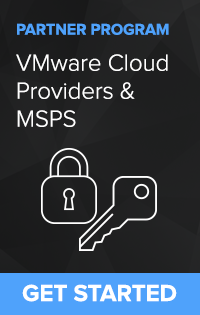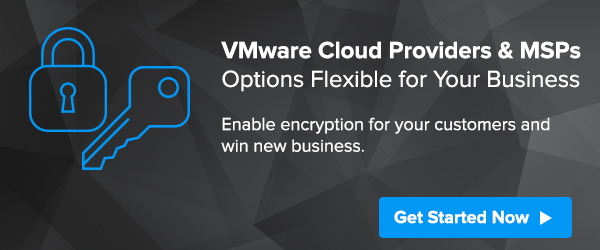VMware has been very sensitive to the security needs of its Enterprise customers. They know that VMware infrastructure and applications are critical to an organization’s overall security. Network segmentation, access controls, monitoring and many other VMware applications help the MSP protect their customer’s applications and data. When it comes to encryption of sensitive data, VMware has your back, too!
 Encryption of VMs was introduced with vSphere 6.5. With this version you could easily select VMs that you want to be encrypted, and quickly and easily start encryption. The MSP VMware administrator can easily see which VMs are encrypted and which were not. Of course, the architecture fit right into the normal VMware architecture. vCenter, vSphere, ESXi all come into play during the implementation and maintenance of the encrypted state of the VMs. A real bonus is that the performance of encrypted VMs is stellar. MSPs rarely need to add additional resources to implement encryption of VMs.
Encryption of VMs was introduced with vSphere 6.5. With this version you could easily select VMs that you want to be encrypted, and quickly and easily start encryption. The MSP VMware administrator can easily see which VMs are encrypted and which were not. Of course, the architecture fit right into the normal VMware architecture. vCenter, vSphere, ESXi all come into play during the implementation and maintenance of the encrypted state of the VMs. A real bonus is that the performance of encrypted VMs is stellar. MSPs rarely need to add additional resources to implement encryption of VMs.
Encryption of vSAN was introduced in vSAN 6.6. The implementation of encryption support is quite different than encryption of VMs, but the encryption key management interface is exactly the same (more on that below). vSAN encryption has been a boon to MSPs. Typically the MSP has relied on storage hardware encryption which often is less expensive, but harder to manage. And encryption key management is generally weak in hardware solutions. Using vSAN lets the MSP integrate the rich set of VMware applications and security. With vSAN encryption you get a flexible place to store commercial and open source databases, big data repositories, and much more. All encrypted efficiently by VMware.
Some MSP customers want to implement TPM to protect their application OS images. Hardware based TPM has many disadvantages in a VMware environment. However, VMware now supports virtual TPM (vTPM) which is much more flexible and resilient in VMware infrastructure. And the good news is that vTPM handles key management in the same was as vSphere encryption of VMs and vSAN encryption of directories. A big plus!
With all of this great support for encryption, how do we properly manage encryption keys? This is a core requirement of compliance regulations and security best practices. VMware handles this well. The key management configuration is provided by the vSphere KMS Cluster configuration. With KMS Cluster configuration you can configure your key management interfaces one time and all of the VMware encryption applications use this definition. And more good news – the interface to key management systems is based on the open OASIS Key Management Interoperability Protocol (KMIP). This means that you have a lot of flexibility and choice in your acquisition and deployment of a KMS for your encryption deployment. (We will talk more about our Alliance Key Manager solution in a following blog).
Key management systems are inherently complex, and the KMIP protocol is also complex. As an MSP you don’t have to deal with this complexity, VMware handles all of the technical implementation. To help VMware customers and partners understand which KMS systems work well with VMware, they make available a certification program for KMS vendors. A KMS vendor who implements the KMIP standard (we are one) can certify their solution for use with VMware. This really sets VMware apart from many infrastructure platform providers. They have made the certification process easy for KMS vendors and publish the results. This means the MSP has an easy way to determine if a key management system is compatible and reliable.
All VMware releases that support encryption also support encryption key management in the same way. This consistency from one release to the next means no disruption to the MSP operating environment after an upgrade, and assurance of the MSP investment in internal training and KMS investments.
Version 7 of VMware now supports a new encryption security interface called Trusted Authority, or vTA. The previous encryption interfaces are still fully supported, but now you have a new option for encryption and key management. vTA offers slightly different architecture and a higher level of security that some organizations need.
All of these features that VMware has implemented make it easy for the MSP to provide encryption support to end customers. In the next blog we will talk about the challenges MSPs face and how to overcome them.
[For More Reading]
Part 1: Why Do MSP Customers Want Encryption of Their VMs and vSAN?
Part 2: What Has VMware Done to Help with Encryption Security
Part 3: What are the Biggest Obstacles to Offering VMware Encryption to Customers
Part 4: How Does Townsend Security Help and MSP Overcome the KMS Challenge?
Part 5: KMS for Multiple vCenter Clusters and Nodes
Part 6: As an MSP, How Do I Ensure High Availability (HA) for Encrypted VMs?
Part 7: How Can an MSP Use Encryption Security to Improve Revenues and Profitability?
Part 8: Some Common Questions and How to Get Started with the Townsend Security MSP Partner Program

